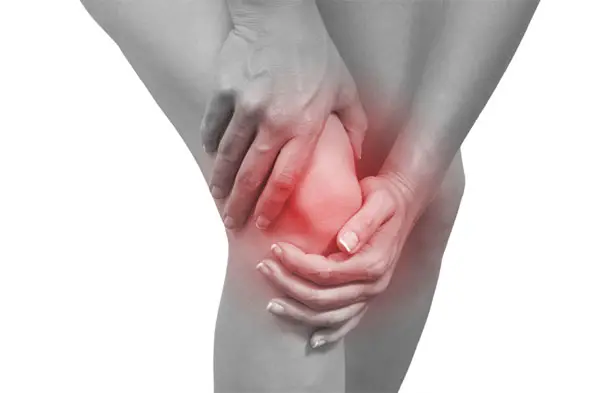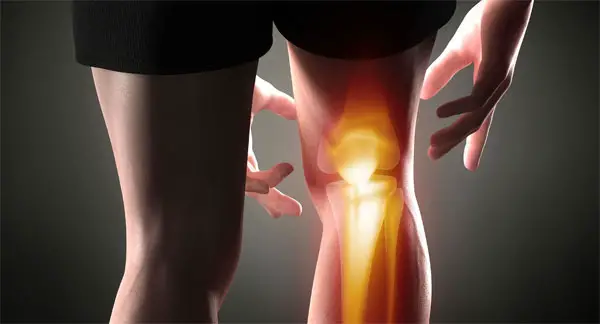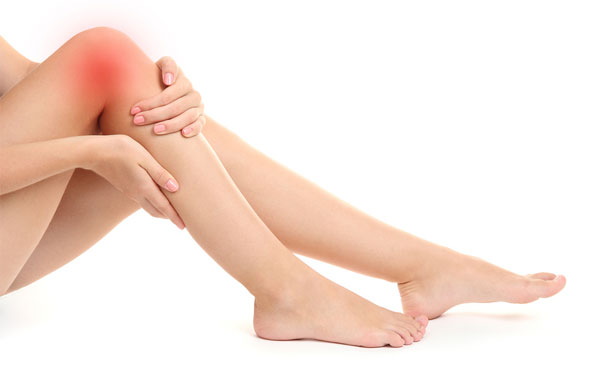
you have chronic knee pain, then you know just how much this pain can affect everyday functioning, from getting up in the morning to playing with the kids, and even just walking to get the mail.
For the millions of people who suffer from knee pain, it can be overwhelming enough to deal with the daily pain, let alone to try and fix the underlying problem.
However, if you can better understand what causes knee pain, you can start taking steps to relieve yours and prevent any future knee complications.
Knee pain from injury
The most obvious cause of some kinds of knee pain is that which is connected to an immediate injury. In most cases, this type of pain will be temporary, in that over time you will heal with proper treatments, ideally not feeling any long-term effects.
Patella damage, or damage to the cartilage that is under the kneecap, can make walking incredibly painful. This can be caused by trauma to the knee, or by consistent high-impact activity.
Dislocation occurs when the kneecap is shifted out of place due to impact or injury. This happens in accidents, but it also common in athletes like dancers, who can easily land poorly from a jump and dislocate their knees. A full dislocation can occur, in which case you won’t be able to use the joint and you’ll probably see the kneecap actually out of place.
Meniscus tears may come from overuse or from immediate trauma such as a sudden twist, and is when your knee’s cartilage tears. The meniscus is essential in reducing the shock placed on legs during the course of the day.
Torn ligaments are particularly common in athletes and active individuals, with the ACL (anterior cruciate ligament) and/or the MCL (medial collateral ligament) being the focus of the injury. A torn ligament will affect the connection of your shin and thighbones, and can greatly impact daily functioning.
Iliotibial band syndrome is when a tightening occurs in the ligament connecting the pelvis to the tibia, and can cause pain along the leg. Runners are often susceptible to pain related to this tight feeling.
Overcompensating due to injury in other areas of the body often places undue amounts of stress on the knees. Particularly for those with injuries in the feet and/or hips, a change in the way you walk or stand can contribute to knee pain.
Knee pain not from injury
If you are in an accident and suffer an injury, you can probably connect new knee pain to that. But sometimes, knee pain seems to come from nowhere.
The truth is, knee pain can also be caused by a number of seemingly unrelated things that you do on a regular basis. For those who suffer chronic knee pain, it is likely that certain parts of your routine may be contributing.
Improper footwear or old, worn shoes is a key way to put pressure on joints that can have ill long-term effects. Look at your shoes, and make sure that everything is in good shape.
Especially if you walk a lot of spend lots of time on your feet, not having sufficient soles can lead to far too much excess work on the part of your knees to absorb the shock of every step.
Excess weight and obesity are some of the leading causes of knee pain that is not related to injury. Your body’s frame is designed to hold an optimal amount of weight, and anything more than that will impact the strength of the structure.
Think of the roof on your house, and imagine replacing it with concrete blocks. It’s likely that over time your walls will buckle under the weight; the same thing can happen with your knees and joint if you are overweight.
Overuse may cause patellar tendonitis, which is exacerbated by stairs and walking on non-flat surfaces. Swollen or sore tendons can impact both your muscles and your joints.
Bursitis is when the area becomes inflamed because of overuse or from an injury, causing a bursa – or fluid sac – to become swollen and painful. Repetitive kneeling can contribute to bursas.
Arthritis can contribute to knee pain, and may be caused by age or by other complications. Gout occurs when there is too much uric acid, and affects joints greatly.
Osteoarthritis due to years of use and joint deterioration is also a leading cause of knee pain, particularly in adults over the age of 50. Rheumatoid arthritis can cause significant damage to the joints, and is often very painful.
Osgood-Schlatter disease is very common in active young children, and sufferers will notice a bump form on the connection between the shin and the knee.
Patellofemoral pain syndrome commonly affects girls in their teenage years, and is typically due to an imbalance in muscles and leg alignment. Sometimes older adults who already have arthritis can develop this.
Loose body is when parts of a bone or cartilage may break off, affecting the knee area if they get stuck in the joint.
Risk factors for chronic knee pain
Aside from injury and pain, knee pain can also be a chronic problem that causes many problems in the day-to-day life of sufferers.
High impact athletes and very active individuals are at risk for injury and stress put on knees over time.
Often, these people will overlook knee pain as something that comes with the territory of their activity levels, but when not properly addressed and treated, this can lead to long-term issues. Skiers and basketball players are often at greater risk for knee injuries.
Stretching and proper warm-ups and cool downs are essential for most level of activity, whether high-impact or not.
Not stretching can lead to instant injury in your knees and other parts of the body, and improperly stretching can also lead to pain. Ensuring that your muscles are strong and flexible can help offer greater support to the knees.
A sprained or strained joint elsewhere in the body, such as an ankle, may cause you to rely on your knees to overcompensate for the weakness in those areas, which can create long-term pain in your knees. Similarly, if a sprained or strained knee isn’t properly treated, it can lead to chronic pain in the future.
Those with poor posture are placing undue stress on many different parts of their bodies, but this can also lead to knee pain fur to the way you walk or the way you stand. Similarly, those who suffer from misaligned legs or spinal misalignments can be at a greater risk for knee pain.
Overweight people often suffer from knee pain, as there is too much stress being places on these joints everyday. Even the simplest of activities can cause undue stress being placed in the area, and of course, those with excess weight or obesity problems are often more susceptible to developing forms of arthritis.
What are the symptoms of knee pain?
Knee pain can manifest in different ways, and won’t always mean the same thing from person to person.
Knee pain from injury will likely be associated with pain that is immediate and clearly tied to a cause.
However, some knee pain may only show up when the knee is being used, which is typically a more focused area and a sharper pain. This pain can range from mildly discomfort to severely incapacitating.
Certain types of knee injury or stress may also cause you to feel pain when you touch your knee in different areas.
Typical complaints related to knee pain are the inability to put weight on the affected leg, extreme swelling, and the inability to bend or straighten the knee.
When to see a doctor for knee pain
In the case of an injury that causes severe pain, see a doctor immediately to address any other complications.
If you’re feeling recurring knee pain with no obvious cause of immediate injury, it is likely that seeing a doctor is still in your best interest, as you can cause more damage by not properly treating a knee, and he or she will be able to see if there are any underlying causes contributing to your pain.

How will a doctor diagnose the cause of knee pain?
For a doctor to help figure out the source of your knee pain, it is likely that he or she will have to perform a series of imaging techniques to see what is affecting the immediate knee area.
X-rays and CT scans are the most common of these, although you may need to be referred to a specialist to have the results properly analyzed.
Blood tests may also be performed if your doctor suspects an underlying cause of your knee pain.
How to reduce knee pain medically
Most medical professionals will prescribe a combination of pain medication and RICE (rest, ice, compress, elevate) to immediately reduce pain and swelling.
Resting your knee can seem impossible with all of the realities of a busy everyday life, but being able to give your aching joints a break is a great way to reduce inflammation and decrease your pain. Sufficient amounts of rest are often required to reduce long-term complications.
Ice is a great way to reduce inflammation on any part of your body. You never want to apply ice directly to the area, as this can injure surrounding muscles and ligaments, but do try applying a cold pack to the area for around 15 minutes at a time, several times a day. If you don’t have a cold pack, place a towel between your skin and a plastic bag of ice.
Compressing swollen areas helps to reduce swelling, and can often be combined with ice.
Elevating injured and inflamed areas allows for blood to flow better to the area by making sure that excess buildups that cause bruising or swelling flows throughout the body.
Over-the-counter anti-inflammatories such as Advil can help relieve pain and reduce swelling.
If you are suffering from a particular cause of knee pain like bursitis, your doctor will be able to address the problem by draining excess fluid from the knee area.
Similarly, for those who have knee pain resulting from arthritis, having regular injections to the area can help boost strength and keep chronic pain down.
Unfortunately, in the case of severe injury, surgical intervention is often necessary. For those with a ligament tear of the ACL or MCL, immediate surgery may not be necessary, but surgical intervention is required to put the ligaments back together.
Physical therapy is often prescribed for those who have knee and body pain, as it is an effective treatment both for alleviating discomfort in the area and for rebuilding strength in the immediate and related areas. This helps to make sure you don’t cause other problems while recovering from your knee pain.
A doctor can also help prescribe you a support device to restrict movement while your knee heels.
How to reduce knee pain naturally
Expensive medications and ongoing treatments may not be a long-term option for you, and the prospect of surgery frightens many who suffer from knee pain. However, there are a number of natural remedies that you can do at home to help reduce pain and regain strength.
Always remember RICE (rest, ice, compress, elevate) as a great first line of defense after new injuries or when pain starts being a problem.
It may seem surprising, but there are things that you can add into your diet to help decrease knee pain. Apple cider vinegar has long been celebrated as a way to detoxify your body and keep joints functioning optimally. Ginger can help reduce swelling and help get rid of bad toxins – you can either drink it or massage oil on the knee area.
Soaking in a warm Epsom salt bath is a great way to help you relax and feel less pain. Plus, since knee pain is often responsible for promoting other aches and pains in the body that overcompensates for the weakened knee, this can make sure your entire body is receiving positive effects.
While resting is essential for the period following injury, staying active and exercising however you can is a great way to promote blood flow and keep areas strong.
Too much rest can lead to muscle atrophy and can actually make your joints stiffer, so low-impact walking and stretches can both help you feel better and make you heal faster.
Make sure you are wearing the proper shoes, with optimal ones having lots of cushioning. Skip the high heels, as these have been shown to increase strain on the knees and other joints.
Incorporate stretching into your daily routine while immediately recovering from knee injuries and if you are simply suffering from daily chronic knee pain.
Stretching will help oxygenate the muscles, keeping them strong and doing the brunt of the hard work for your body. Keeping joints limber and lubricated will ensure that you reduce further complications.
How will I know when my knee is better?
People heal at different rates, and because there are so many causes of knee pain the amount of time it takes to recover can vary greatly.
You should always talk to a doctor before resuming higher levels of activity after an injury or if you just suffer from constant pain.
Likely, he or she will recommend not going back to activities until you can bend and straighten your leg with no pain, you can stand on your leg without pain, and you don’t feel pain when walking or jumping.

Long-term prognosis for knee pain sufferers
How long you suffer from knee pain will likely be due to the causal factors behind it.
For knee pain caused by some forms of arthritis, it is likely that pain is permanent, because the knee itself is actually damaged. However, your doctor will be able to prescribe you medications that will help reduce pain and swelling.
For those suffering from knee pain related to an injury, it is likely that your pain will only be temporary so long as you follow all of the recommended treatments for the area.
Many people stop undergoing physical therapy or other interventions when they start feeling better, but if strength is not fully restored to the area, pain can return in the future.
If your knee pain comes from overuse and a high level of activity, you may have to adjust your routine, particularly as you age. Low-impact walking and water aerobic routines can have equally as much impact as running. Try mixing up your routine so you are able to stay active but also don’t overstress an area.
If your job or lifestyle requires constant kneeling, consider purchasing knee pads as a way to protect your knew from hard surfaces and constant impact.
Always be aware of when you start feeling pain in your knee when you are active, and always stop if you feel sharp, immediate pain, as they may signify injury.
References
http://www.healthline.com/health/chronic-knee-pain#1
http://www.webmd.com/pain-management/knee-pain/default.htm
http://www.mayoclinic.org/diseases-conditions/knee-pain/basics/definition/con-20029534